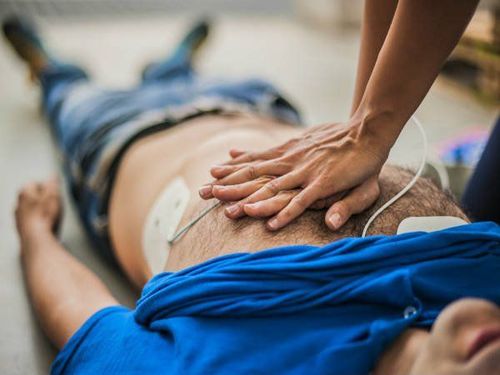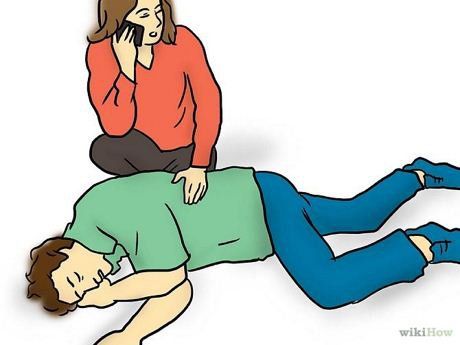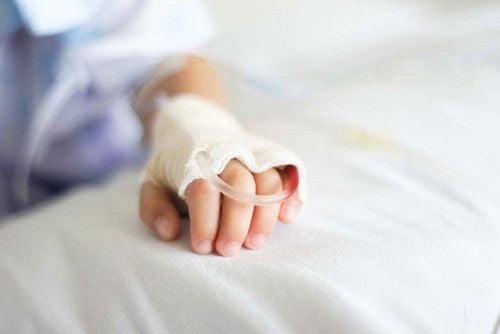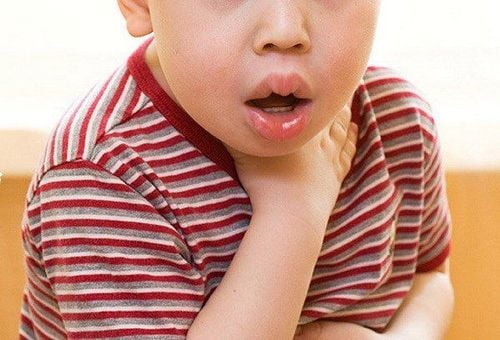This is an automatically translated article.
Infant choking can cause airway obstruction if not handled promptly. Therefore, equipping children with first aid skills when choking will help you handle them quickly if this unfortunate situation happens to your child.
1. First aid when a child is choking
Children are often very curious, want to try many things on their own, and always encounter many dangerous situations such as choking on food, or putting foreign objects in their mouths causing airway obstruction. At that time, if parents or people around know and follow the right first aid and CPR steps, it will make a significant contribution to saving the child.
Step 1: Assess the situation quickly.
If your baby suddenly can't cry, cough or even speak, it's possible that his airway is blocked and the first thing you need to do is help him get it out. Signs of a baby choking are that the child may make strange sounds or speak out of voice, the skin becomes red or even blue-violet.
If the child coughs or vomits, it means that the child's airway is partially blocked. In this case, you should let the child continue to cough, coughing is the most effective way to clear the obstruction.
If the child is unable to cough up the object, you should have someone else call 911 or your local emergency department while you perform back patting and abdominal compressions.
If your baby suddenly can't cry or cough, it's possible his airway is blocked and the first thing you need to do is help him get it out. The child may make strange noises or make no sound at all when he opens his mouth. Your baby's skin may become red or bluish.
Contact the doctor immediately if the child has any of the following problems:
The child cannot cough up a foreign object. You should perform back pats and abdominal thrusts while contacting 115. You suspect that the child's airway is completely blocked because of the swelling in the child's throat. Your child may have an allergic reaction - to food or an insect bite, for example - or he or she may develop an illness, such as lung cancer. Children at high risk of heart disease Children suddenly have a stroke.

Khi trẻ không thể ho được dị vật cần được đưa đến bệnh viện
Step 2: Attempt to remove the foreign body with back patting and abdominal thrusts
First back patting
If the child is awake but unable to cough, cry or breathe and you are sure something is stuck in the the infant's airway, carefully lay the child on his or her back on one forearm, with that hand cupping the nape of the neck. Place your other hand and forearm in front of the child. The baby is now sandwiched between your arms. Use your thumb and fingers to hold the baby's jaw and turn him over so he's facing down along your forearm. Lower your arms onto your thighs so that the child's head is lower than his chest. Using the heel of your hand, deliver five firm and firm back blows between the child's shoulder blades to try to dislodge the object. Maintain stability of the baby's head and neck by firmly holding the child's jaw between your thumb and index finger. If the foreign body does not come out, place your other hand (the hand that received the back blow) on the back of the child's head with your arm along the child's spine. Carefully turn the young person over while keeping your other hand and forearm in front of the young person. Then do a tummy tuck
Use your thumb and fingers to hold the baby's jaw while clamping the baby between your forearms to support the head and neck. Lower the arm supporting the baby's back onto your lap, keeping the baby's head lower than the rest of the body. Use one or two fingers to locate the navel. With one hand clenched like a fist, for example, the right hand, place the fist above the navel and below the breastbone, then the left hand grasps the fist and presses the abdomen up to the abdominal wall, do 5 times. Each abdominal thrust should be firm and firm to remove the obstruction. Repeat back patting and abdominal presses
Repeat back patting and abdominal press therapy. Continue alternating five back pats and five abdominal thrusts until the object is expelled and the child begins to cough forcefully. If the child is able to cough, encourage the child to continue coughing up the object. If the child is unconscious
If the child is suffocated by something becomes unconscious, lay the child down on a hard surface and start CPR. After each compression and before giving CPR, open the infant's mouth, locate the obstruction, and remove the foreign body if possible.
Never put your finger in a child's mouth unless you can really locate the foreign body. If you can't see it and put your finger in the baby's mouth, you could accidentally push the object deeper into the child's throat. If you can see the foreign body, remove it with your little finger.
Continue doing this until the child wakes up or the medical staff arrives.

Khi trẻ bị bất tỉnh hãy tiến hành hô hấp nhân tạo cho trẻ
2. Perform CPR when the child is choking
CPR stands for cardiopulmonary resuscitation technique. This is a helpful lifesaving measure you can take to save a child who has no signs of life, meaning he is unconscious and not breathing.
CPR is a combination of chest compressions and artificial respiration to restore oxygen-rich blood to the brain and other vital organs until the baby is resuscitated or paramedics arrive. Keeping oxygen-rich blood circulating helps prevent brain damage - which can happen within minutes - and death of a child.
Infant CPR is not difficult to do. Steps to perform CPR include:
Step 1: Verify that the child is unresponsive and not breathing.
Shout to get the child's attention by calling out the child's name. If the child is unresponsive, tap the bottom of the foot and scream again while checking for normal breathing. (Look to see if the baby's chest goes up and listen for breathing.) If the child is unresponsive and is not breathing or gasping, have someone call 911 (If you are alone with the child, give first aid to the child and then call 911.) Quickly place the child on his or her back on one side. flat gently and firmly. You can stand or kneel next to the child. You need to determine if the child is bleeding profusely. If the child is bleeding profusely, take measures to stop the bleeding by applying pressure to the area. Do not perform CPR until bleeding is controlled. Step 2: Do 30 chest compressions.
Place one hand on the child's forehead. Kneel next to the child's chest, place the heel of your hand on the breastbone, in the center of the chest area. Place your other hand directly on top of the other. Try to keep the hand from falling off the chest by interlacing fingers or using the upper hand to hold it. Using the weight of the upper body, press the victim's chest straight down to at least 5cm deep, press hard and fast, then let the chest return return to normal position. Press firmly, quickly and firmly. Straighten the victim's chest continuously at a frequency of 2 times per second.
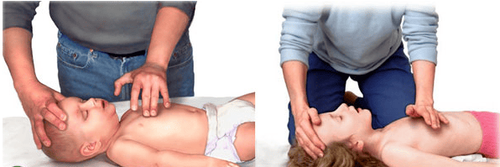
Thực hiện CPR khi trẻ bị nghẹt thở
Step 3: Give CPR
Note: If you are not ready to perform CPR, chest compressions only will be better than doing nothing at all. Open the airway by placing one hand on the child's forehead and two fingers on the chin and tilting the child's head, lifting the child's chin to open the airway. Clamp the nose firmly and breathe into the child's mouth. Breathe normally and blow into the child's nose and mouth for about a second, watching to see if the chest expands. If the chest does not rise, hold the baby's head and clamp the nose firmly before giving a second breath. If the infant's ribcage does not rise, the infant's airway is blocked. Open the child's mouth, locate the blockage, and remove the foreign body if possible. Continue to check the mouth for foreign bodies after each compression until the child's chest expands as the breath comes in. Continue doing 30 chest compressions and 2 breaths until:
You notice a clear sign of life in the baby. Using an AED (automatic external defibrillator) You have performed CPR for about 2 minutes (5 chest compressions and CPR) and someone assisted. Medical staff arrived. You are too tired to continue. Even if the baby's vital signs return, the doctor will also conduct an examination to make sure that the child's airway is completely clear and that the child is not suffering any internal damage.

Khoa Cấp cứu của Bệnh viện Đa khoa Quốc tế Vinmec đã cứu sống những bệnh nhân nặng, phức tạp
The Emergency Department of Vinmec International General Hospital operates 24/24 on all days of the week, including Saturday and Sunday as well as holidays of the year. The team of emergency doctors and nurses at the Department are professionally and thoroughly trained, able to receive and handle urgent cases of patients, and always coordinate with all specialties in a timely manner. fast.
With modern equipment and a team of experienced doctors, the Emergency Department has conducted emergency and saved the lives of serious and complicated patients. At the same time, patients at the Emergency Department are always coordinated care by many other specialized specialties (Team Base Care). Therefore, at the Emergency Department, patients will be examined, diagnosed, accurately and quickly, with high reliability and intensive treatment right from the emergency stage to help them quickly get out of the critical stage. dramatic and stable.
Please dial HOTLINE for more information or register for an appointment HERE. Download MyVinmec app to make appointments faster and to manage your bookings easily.
Reference source: babycenter.com





